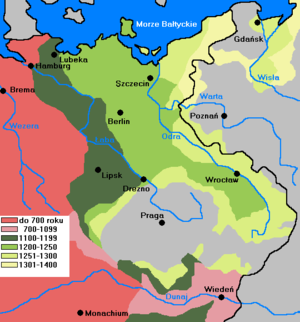You can help expand this article with text translated from the corresponding article in German. (September 2010) Click [show] for important translation instructions.
|

Germania Slavica is a historiographic term used since the 1950s to denote the landscape of the medieval language border (roughly east of the Elbe-Saale line) zone between Germanic people and Slavs in Central Europe on the one hand and a 20th-century scientific working group to research the conditions in that area during the Early Middle Ages and High Middle Ages on the other.[1][2]
The historian Klaus Zernack divides Germania Slavica into:[3]
- Germania Slavica I between the Elbe and Saale rivers in the west and the Oder in the east, which had formed part of the Frankish and later Holy Roman Empires as marches
- Germania Slavica II east of Germania Slavica I and west of the Kingdom of Poland, comprising the Silesian, Pomeranian, and Prussian duchies as well as the Neumark.
From the late first millennium CE, Slavic tribes (collectively referred to as Wends) settled in Germania Slavica. The area underwent great social transformations associated with the influx of settlers from the West (primarily Germanic people) during the Ostsiedlung in the Early Middle Ages and High Middle Ages. The consequences of Ostsiedlung would be long lasting with the social structure of "East Elbia" (German speaking lands east of the Elbe river) being dominated by latifundia and Prussian Junkers until the land reform and expulsion of most ethnic Germans following the Second World War. By contrast, the rest of German speaking Europe was dominated by small farms and increasing urbanization.
By analogy, the term Bavaria Slavica denotes the medieval German-Slavic contact zone in northeastern Bavaria.
- ^ Christian Lübke, Struktur und Wandel im Früh- und Hochmittelalter: eine Bestandsaufnahme aktueller Forschungen zur Germania Slavica, Franz Steiner Verlag, 1998, p.9, ISBN 3515071148
- ^ J. Hackmann. "From Germania Slavica to Slavia Germanica? (От Germania Slavica к Slavia Germanica?)// Studia Slavica et Balcanica Petropolitana". Hackmann J. From Germania Slavica to Slavia Germanica? (От Germania Slavica К Slavia Germanica?)// Studia Slavica et Balcanica Petropolitana. № 2(22). 2017. С. 122-139. Academia. Retrieved September 6, 2020.
- ^ Christian Lübke, Struktur und Wandel im Früh- und Hochmittelalter: eine Bestandsaufnahme aktueller Forschungen zur Germania Slavica, Franz Steiner Verlag, 1998, p.14, ISBN 3515071148